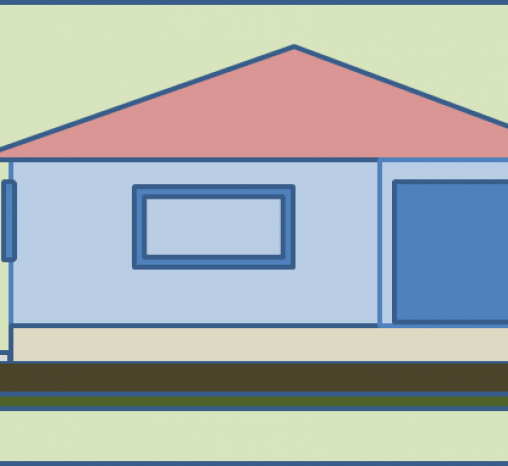Garage repairs and rebuilds in Canterbury's green zone

If you are repairing or rebuilding a garage in Canterbury’s green zone, you need to consider where it is and how it is used.
You need to consider:
- which technical category (TC1, TC2 or TC3) the garage is in
- whether it is a freestanding garage or attached to a house
- whether anyone lives in the garage.
Garages and earthquake risk
Freestanding garages do not have to meet the same earthquake design loads as houses because they are not designed to be lived in. People’s safety is not normally at risk if a garage is damaged in an earthquake.
However, if a garage is attached to the house then it must be designed to the same performance standard as the main house.
Garage foundations in TC2 areas
Freestanding garage - if your garage is freestanding and uninhabited, you do not need to have foundations specially constructed to counter the effects of liquefaction. You should be able to meet the Building Code requirements with a suitable structure on a TC1 foundation (for example, a standard NZS3604:2011 foundation).
Attached garage - if your garage is attached to your house, and your house has been redesigned with TC2 foundations, then the garage will also require TC2 foundations.
Garage foundations in TC3 areas
- Freestanding garage - If your garage is freestanding, lightweight and uninhabited you can usually use TC2 foundations, even if the house repair or rebuild requires TC3 foundations. You could also get advice from a chartered professional engineer. In some locations you can use simpler foundations (ie TC1 foundations) for lightweight garages.
- Attached garage - If the garage is attached to your house and your house has been rebuilt with TC3 foundations, then the garage will require TC3 foundations.
Garages typically have concrete foundations. Where a TC3 surface structure foundation solution (eg a raised timber floor supported on short piles) is used for the house, then an attached garage will require specific detailing to avoid damage from differential movement. You should get advice from a chartered professional engineer on this matter.
TC3 garage construction materials
If your property is in a TC3 area MBIE guidance recommends you build a garage with lighter weight cladding and roofing (eg weatherboard, profiled metal or plywood for the wall cladding, and sheet metal or metal tiles for the roof).
Garages and covered ways
A garage connected to the house by a covered way may be considered freestanding if:
- it has a separate foundation system
- there is adequate provision in the superstructure for differential movement.
A garage connected to the house by a covered way would be considered attached if:
- the garage and house are on a continuous foundation system.
It is recommended that the walls between the garage and house are no closer than 900mm and the eaves are separated by more than 300mm.
Where a new covered structure is built linking a house and garage this structure still needs to comply with the Building Code.
In some instances, you might be able to get a building consent exemption for a covered walkway or linkage between buildings. You need to look at Building work that does not require a building consent in paragraph 7 of Schedule 1 of the Building Act, 2004 (March 2014).
Building consent and a garage repair or rebuild
If you are repairing or rebuilding a small detached uninhabited building, such as a garage, you do not need a building consent if:
- the repair or replacement is made within the same area that the outbuilding or the original outbuilding (as the case may require) occupied
- in the case of any replacement, the replacement is made with a comparable outbuilding or part of an outbuilding.
This information is from clause 7 of Schedule 1 of the Building Act, 2004 (as at 1 January 2014).
If you are in doubt, you should talk to your local council.
Resource consent and a garage repair or rebuild
You will not normally need resource consent if you are rebuilding or repairing a garage to the same dimensions and in the same location as before.
You may need resource consent if the rebuild or repair results in a change to the dimensions or location of the garage and that change subsequently breaches a bulk or location rule in the Christchurch City Plan.
You may also need resource consent if your site is within a special amenity area. These areas have rules relating to the external appearance of buildings. In that instance, you need to ask your local council for advice. BCA register has council contact details.

Figure 1: A house with an attached garage requires the house and garage to have a common foundation type.

Figure 2: For a house with a detached garage, the house and garage may have different foundations depending on the land categorisation.
You can find more technical information about garages on this website in:
- Part A section 5.6 and Part C section 11.3 of the December 2012 guidance Repairing and rebuilding houses affected by the Canterbury earthquake
- Codewords issue 35 guidance on garage classification
- Building work that does not require a building consent (March 2014). This document procides guidance regarding paragraph 7 of Schedule 1 of the Building Act, 2004.